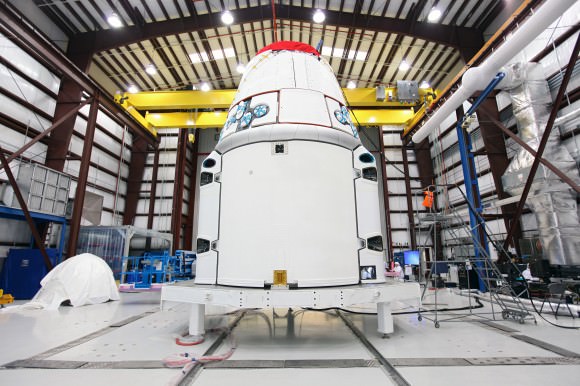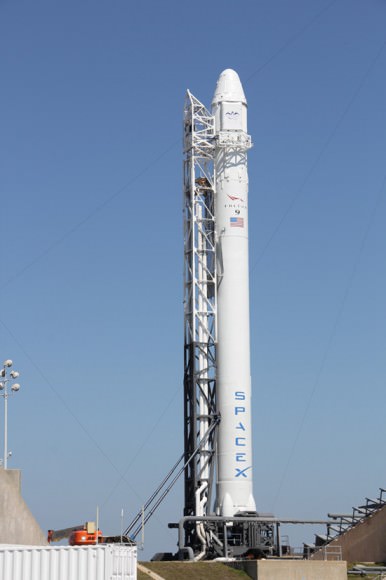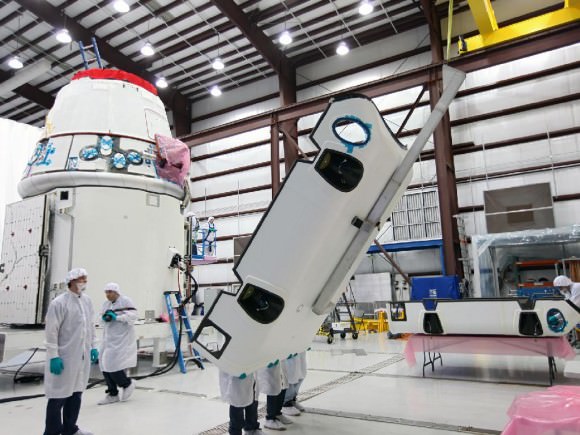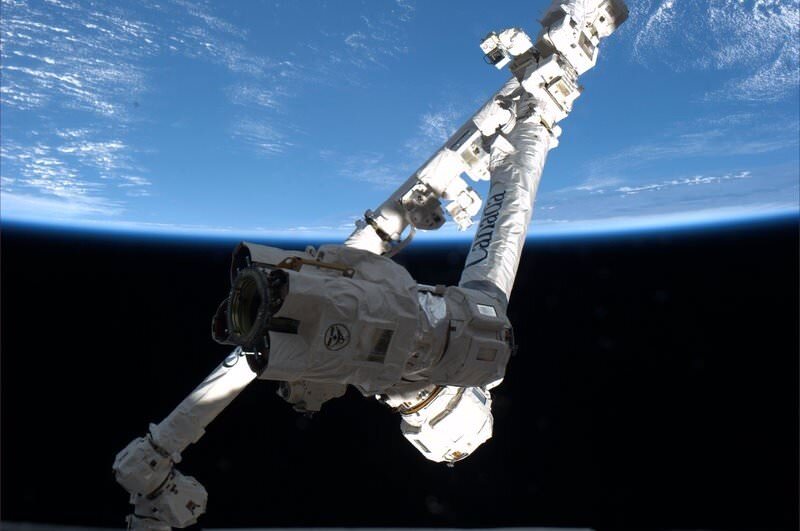Wouldn’t you love to wake up to this gorgeous view of our home planet as a big hand waves a friendly good morning ?!
Well, having survived high speed wayward Asteroids and Meteors these past few days, the human crew circling Earth aboard the International Space Station (ISS) is game to snatch a flying Space Dragon before too long.
NASA will dispatch astronaut fun to orbit in the form of the privately built SpaceX Dragon in a tad less than two weeks time that the crew will ensnare with that robotic hand from Canada and join to the ISS.
On March 1 at 10:10 AM EST, a Space Exploration Technologies (SpaceX) Falcon 9 rocket is slated to blast off topped by the Dragon cargo vehicle on what will be only the 2nd commercial resupply mission ever to the ISS.
The flight, dubbed CRS-2, will lift off from Space Launch Complex 40 at Cape Canaveral Air Force Station in Florida carrying about 1,200 pounds of vital supplies and science experiments for the six man international crew living aboard the million pound orbiting outpost.

The ISS would plummet from the sky like a flaming, exploding meteor and disintegrate without periodic and critical cargo and fueling resupply flights from the ISS partner nations.
There will be some heightened anticipation for the March 1 SpaceX launch following the premature shutdown of a 1st stage Merlin engine during the last Falcon 9 launch in 2012.
The solar powered Dragon capsule will rendezvous with the ISS a day later on March 2, when NASA astronauts Kevin Ford and Tom Marshburn will reach out with the Canadian built robotic marvel, grab the Dragon by the proverbial “tail” and attach it to the Earth-facing port of the station’s Harmony module.
The Dragon will remain docked to the ISS for about three weeks while the crew unloads all manner of supplies including food, water, clothing, spare parts and gear and new science experiments.
Then the astronauts will replace all that cargo load with numerous critical experiment samples they have stored during ongoing research activities, as well as no longer needed equipment and trash totaling about 2300 pounds, for the return trip to Earth and a Pacific Ocean splashdown set for March 25 – as things stand now.

SpaceX is under contract to NASA to deliver about 44,000 pounds of cargo to the ISS during a dozen flights over the next few years at a cost of about $1.6 Billion.
SpaceX comprises one half of NASA’s Commercial Resupply Services program to replace the cargo up mass capability the US lost following the retirement of NASA’s space shuttle orbiters in 2011.
SpaceX also won a NASA contract to develop a manned version of the Dragon capsule and aims for the first crewed test flight in about 2 to 3 years – sometime during 2015 depending on the funding available from NASA.
The US is now totally dependent on the Russians to loft American astronauts to the ISS on their Soyuz capsules for at least the next 3 to 5 years directly as a result of the shuttle shutdown.
Along with SpaceX, Orbital Sciences Corp also won a $1.9 Billion cargo resupply contract from NASA to deliver some 44,000 pounds of cargo to the ISS using the firm’s new Antares rocket and Cygnus capsule – launching 8 times from a newly constructed pad at NASA’s Wallops Island Facility in Virginia.
The maiden launch of Orbital’s Antares/Cygnus system has repeatedly been delayed – like SpaceX before them.
NASA hopes the first Antares/Cygnus demonstration test flight will now occur in March or April. However, the Antares 1st stage hot fire test scheduled for earlier this week on Feb. 13 had to be aborted at the last second due to a technical glitch caused by a low nitrogen purge pressurization.
For the SpaceX launch, NASA has invited 50 lucky social media users to apply for credentials for the March 1 launch
Watch for my upcoming SpaceX launch reports from the Kennedy Space Center and SpaceX launch facilities.



Will the arm arm on the ISS always grab the Dragons, or will they ultimately be able to dock to the station by themselves?
good question. the manned Dragon will be required by NASA to be docked by the crew. cargo Dragon will continue to be grappled
The cargo version of the Dragon uses the common berthing mechanism (CBM), which is not able to “dock”, since it is just a hard connection. That is why the Canadarm is needed to grab the vehicle and “berth” it. The CBM is also used to connect ISS modules, and it’s not really meant for vehicles that need to leave at a moments notice.
The crew version of the Dragon will use the NASA Docking System (NDS), which has capture mechanisms that allow for the kind of low-impact docking we normally see with other crew vehicles. The NDS also allows for fast undocking, which is required in case the crew needs to quickly leave the ISS.
Go SPACE-X!